The Palm Trēo is a line of smartphones originally developed by Handspring, which was purchased by Palm, Inc. They are now manufactured and maintained by Palm, Inc. Trēos have a number of integrated features such as the ability to check the calendar while talking on the phone, dial directly from a list of contacts, and send email messages. Recent models include a built-in camera. Traditionally, Trēos run Palm OS which allows synchronization with both Mac OS X and Microsoft Windows, but newer models also have editions that run Windows Mobile.
Handspring Treo 90 Review
By Ed Hardy
7/1/2002
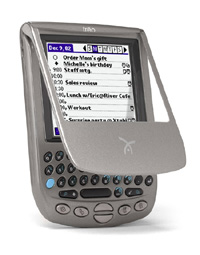 Overview
Overview
The Treo 90 is priced for the mid-range but is still loaded with features. It has a color screen, an SD/MMC slot, and a built-in keyboard. It has 16 MB of memory and runs Palm OS 4.1.
Don't be confused by the Treo name; this isn't a smartphone like the rest of the Treo line.
Screen
The Treo 90 is the first new Handspring product to come out with a color screen since it introduced the Visor Prism in October of 2000.
The screen is 12-bit, instead of the 16-bit screens we've become accustomed to. This means it can display fewer colors, 4,000 instead of 65,000. Does this matter? Depends on what you want to use your handheld for.
I loaded a couple of 16-bit color images onto a Treo 90 and an m505 for comparison and while there was a difference, it wasn't huge. However, if you frequently use your handheld to show people pictures of your latest vacation or houses for sale or something like that, you might want to consider a 16-bit, high resolution screen. If you just want a color screen to play a few games or make eBooks look better, you'll probably be happy with the Treo 90.
I ought to point out that the colors it does show, it shows very well. All the colors are strong; none are washed out or weak. Its whites are nice and white, making a good background for reading text.
At least, that's true indoors. Outdoors is a whole new kettle of fish. The Treo 90's screen depends on being backlit. If the ambient light is brighter than the backlight, the screen becomes unreadable. Now the Treo has a good backlight but it isn't brighter than the Sun. Therefore, it is difficult to use the Treo 90 outdoors. With a lot of playing around you can usually find an angle that will let you see the screen but I don't think you'll be using it outdoors a lot.
Like the rest of the Treo line, Handspring was able to reduce the size of the entire handheld by slightly reducing the size of the screen. However, there aren't any fewer pixels; it is still the standard 160 by 160. The pixels are just smaller and closer together.
I know there are some people who find this unacceptable but I'm not one of them. Heck, I had the Treo 90 for almost a day before I even remembered the screen was a bit smaller. Actually, the smaller screen helps compensate for the lack of a hi-res screen. The smaller pixels make images and fonts look smoother.
Lots of people have asked what the exact screen size is so they can compare it with a Palm m130, which also has a slightly smaller than normal screen. Turns out the two are almost exactly the same size, roughly 1 7/8 inches.
Keyboard
Though not the first handheld to do this, the Treo 90 is still unusual for depending on a keyboard for text input, rather than Graffiti.
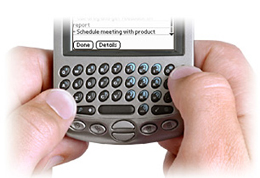 If you are a long time Palm user, this will be a bit of an adjustment. It took me a while to stop pulling out the stylus whenever I wanted to enter some text or open a menu. However, I think first time buyers will be able to get quickly up to speed with the Treo 90 without having to go through learning Graffiti.
If you are a long time Palm user, this will be a bit of an adjustment. It took me a while to stop pulling out the stylus whenever I wanted to enter some text or open a menu. However, I think first time buyers will be able to get quickly up to speed with the Treo 90 without having to go through learning Graffiti.
Of course, with a keyboard only 2.5 inches across, there can be no question of touch typing. Instead, the Treo is held between the two hands and you type with your thumbs. That's why people call it a thumboard.
After about a week of practice, including writing most of this review with it, I've become pretty good at it. In fact, I can already write 15% to 20% faster with the keyboard than with Graffiti, partially because I made fewer mistakes.
Based on that, I think it's a good replacement for Graffiti, though not for everyone. It is at least as good as Graffiti for short notes and better than it for mid-length notes. My hand gets tired after writing a paragraph or two in Graffiti but not with the Treo 90's keyboard. However, I don't think either are best if you are planning to write thousands of words. In that case, you should get a full-sized keyboard.
One thing I've been thinking about is, why is there so much resistance from long time Palm users to this model's built-in keyboard? I finally decided it was the learning curve. For these people, it is going to take some time working with this keyboard to get as fast as they are now with Graffiti. If you never put in more than a few words into your handheld at a time, then learning to use a new input method is a waste of time. But if you write a lot on your handheld, it pays off. However, first time users will get started much faster without having to learn Graffiti, which is harder than getting used to a smaller keyboard.
Cramming a keyboard into a tiny handheld isn't easy and Handspring definitely had to make some compromises. The keys are small and close together, which can make typing tough if you have really big hands.
Of course, they have to limit the number of keys so the ones they have need to do double duty or more. Of course, each key handles both upper and lower case. Punctuation and other special characters are typed by pressing an Option key then the appropriate letter key. Don't worry, the period has its own key.
There still aren't enough keys for all the special characters but the Treo can handle that. I think I can explain this best by example. Pressing Option S types a (. If you then hit yet a third key, which is marked ... for some reason, a pop up window appears on the screen which will allow you to pick from (, <, [, {, or ‹. It's a little cumbersome but it let's you use 34 keys to type about 200 characters.
One of the things I miss is a set of directional keys. If I want to go back just a few letters, I have to pull out the stylus and tap on the screen.
The keyboard takes the place of the Graffiti area so there are no silkscreen buttons. There are keyboard equivalents but they aren't as easy to use as I'd like.
My main complaint with this is you have to press two buttons to open the application launcher. There was a reason why all other Palms have a silkscreen button that does this in a prominent place; because you do it all the time. The Treo 90 makes this too hard.
The new Treo 270's backlight shines behind the keyboard, making it easier to use in the dark. The Treo 90 doesn't have this feature. I have no problem with this. While it is occasionally useful to be able to work in the dark, the rest of the time this is an unnecessary drain on the battery.
SD/MMC Slot
What's a new handheld without a bit of controversy? Handspring leaving out the Springboard slot and putting in an SD one is a little like Ben & Jerry giving up on ice cream putting out a line of salad dressings.
I don't want this to turn into an editorial but I agree with this decision. I think Handspring has accepted that the Springboard wasn't a big success. Modules were never as small as Handspring hoped they would be and most were too expensive. It was a great idea that didn't pan out.
If this makes you angry, think about it from Handspring's perspective. No one wanted more for the Springboard to be successful than the people at Handspring did. If they can accept that their handhelds are better off without it, so should you.
For me, it came down to one thing: Including the Springboard slot limits how small a handheld can be and the Treo 90's small size is one of its best features.
The SD slot allows the Treo to store huge amounts of applications and files. Storage is limited only by your budget in buying SD or MMC cards.
The Treo doesn't come with a file manager. It depends on the Palm OS's ability to run applications off memory cards and individual applications' ability to store and access files from them. However, several third-party file managers are available.
I thought using an SD card was a little sluggish so I tested it with VFSMark, which benchmarks the speed of common tasks VFS memory cards perform, like reading, writing, creating files, etc. My hunch wasn't wrong, the Treo 90 uses its SD slot about 20% slower than an m500, which is VFSMark's default device. Not a big deal but I thought I'd point it out.
One thing I think is a bit disappointing about this model is it doesn't support SDIO. This means it won't be able to use the new Palm Bluetooth SD Card or any other non-memory card. This is too bad as I think a Treo 90 and a mobile phone connected with Bluetooth would be an excellent mobile way to access the Internet and get email.
Update: Handspring has released an update for the Treo 90 that adds support for SDIO. This means it can use the Palm Bluetooth card.
Casing
The overall impression I get from this model is smallness. Looking at the measurements doesn't make it seem very much smaller than any other handheld but in my hands it feels tiny. It's great. I have no problem carrying it in my shirt pocket, which I don't do with any other handhelds.
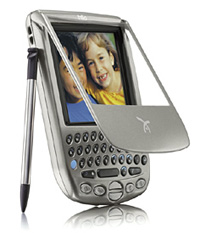 To get down to the details, the Treo 90 is 4.2 by 2.8 by .65 inches (10.8 x 7.1 x 1.6 cm). It weighs only 4 ounces, making it the lightest Palm OS handheld available.
To get down to the details, the Treo 90 is 4.2 by 2.8 by .65 inches (10.8 x 7.1 x 1.6 cm). It weighs only 4 ounces, making it the lightest Palm OS handheld available.
Sound
One thing that caught me off guard about the Treo 90 was the loudness of the internal speaker. It must have the loudest alarm sound on any Palm OS handheld to date. I found myself keeping it on the low setting just for comfort.
Buttons
Like all Palm models, there are buttons on the front for launching applications and which applications these open is set by the user. Handspring, however, has gone the extra mile with this. Pressing the Option key on the keyboard, then the To-Do button, launches CityTime and Option-NotePad opens the Calculator. Sadly, there isn't a way to change these. (Developers, are you listening?)
An additional use for the buttons is for games. On the Treo 90, the buttons are right at the bottom, which isn't the best place for gaming. However, there wasn't a lot of space left over after the screen and the keyboard went in. Like I said, it’s not optimal but still usable.
The flip cover doesn't cover the buttons, which means the Treo might get activated in your pocket accidentally. Fortunately, Handspring thought of this. Holding down the Power button for two seconds locks all the buttons, including the keyboard. Only holding down the Power button again will reactivate them.
I was very sad when I discovered that the Treo 90 doesn't have a jog dial like the rest of the Treo line. I really thought Handspring understood how much easier a jog dial makes using a handheld. Like my mother used to tell me, I'm not angry, just very disappointed.
Still, they added some nice software tricks to try and compensate for not having a jog wheel. When you are in the application launcher, you can scroll through the list of applications with the Up/Down buttons. When the app you want is highlighted, pressing the Space Bar or Return key will open it.
Motherboard
The Treo 90 is the first Handspring model ever to use Palm OS 4.1. All the others, even the new ones, are using OS 3.5. I suspect Handspring made the jump with this one because all the code necessry for the SD slot was already included in OS 4.1 but not earlier versions of the operating system.
The Treo 90 has 16 MB of memory, which I think is great. I was afraid Handspring would be chintzy like Palm did with the m130 and only give it 8 MB. All this memory plus the SD slot allows it to be competitive with even high-end devices.
It doesn't have Flash ROM, which means the operating system can't be upgraded. This is no big deal because there isn't going to be anything to upgrade it to. OS 5 requires an ARM-based processor and the Treo 90's 33 MHz Dragonball VZ isn't one.
I wouldn't be too concerned about the fact that this device won't run OS 5. I strongly suspect that OS 5 handhelds will be high-end devices for a good while after the first ones come out. If you are interested in the Treo, you are probably pretty price conscious and this model is a good deal.
Update: Turns out that the Treo 90 actually does have flash ROM and, to prove it, Handspring released an update that reflashes the ROM. As I said earlier, this adds SDIO support but also does some bug fixes. If you get a Treo 90, I'd suggest you add this patch.
Battery Life
The Treo 90 has a very impressive battery life, especially for a color handheld.
With the backlight on full, the Treo got 3 hours and 55 minutes before the first battery warning. With it on half power, it lasted 10 hours and 5 minutes. I was going to see how long it would last with the backlight on low but the screen is too dim to be usable that way unless you are in very dim light.
I tested battery life by installing an application called UpTime. This tracks the amount of time a handheld is on. Then I used the Treo normally, reading AvantGo pages, playing games, looking up address, and that sort of thing. I think this is a very realistic test as it takes into account that handheld batteries are designed to be used intermittently.
Software
Instead of the standard Address Book, the Treo 90 comes with an app called Contacts 4.1H. It is very similar to the standard address book but with a few more features.
When listing your contacts, the names and phone numbers are on separate lines and all the phone numbers are displayed, not just a default one.
Also, if you begin typing a name, it will only display all the contacts that don't match what you've put in. For example, if you are looking at the full list of all your contacts and you type in "B" and then "I", Contacts will only display people whose first or last name begin with "BI", like someone name Bill Smith or Karen Billingsly.
It can directly dial numbers on some mobile phones via infrared.
It has Date Book+, an enhanced version of Date Book that includes some extra features, like floating events, an improved weekly view, a yearly view, and a list view.
The Treo 90 is bundled with a copy of Blue Nomad's WordSmith word processor, which I reviewed a while back. This is a good app but don't try to use the High Resolution font feature. This takes advantage of the fact that on color screens each pixel is actually made up of three sub-pixels. This is supposed to improve the perceived resolution of the fonts but on the Treo 90 they just look fuzzy.
Stylus
I'll give Handspring credit, they tried to use a good stylus. It is partially metal and very sturdy. Problem is, the stylus slot let's it fall out if you turn the Treo upside down. This happens so often I'm surprised I haven't lost it yet.
This isn't just mine, either. I've heard from numerous people who complained of the same thing. Eventually, I took some advice from one of them and put some tape inside the slot until the stylus was less loose. This isn't perfect but it is much better.
The stylus is about a half inch shorter than the standard one. Not a big deal but it might be a problem if you have big hands.
Flip Cover
The flip cover reminds me of the one from my old IIIx, except this one has a clear window in it. This lets you know what alarm has just gone off without having to open the cover. I'm not sure I like the window. I don't worry about the screen getting scratched but now I worry that the plastic window will. Covers are supposed to get beat up but I'm afraid scratches will really show up on the clear part.
Handspring will probably sell replacements, though. It is supposed to be removable but it isn't easy. I gave up trying to remove mine when it seemed like it was about to break.
Cables
The Treo 90 doesn't come with a cradle. Instead, it has a USB cable for HotSyncing and a separate power cable. The power cable plugs into the USB cable, allowing you to both charge and HotSync your Treo at the same time.
I don't like the lack of a cradle but I can accept it as a cost-cutting feature. You can buy one separately but I think handhelds should be in the hands, or at least the pockets, not hanging around in cradles.
The best feature about the power cable is it can also plug directly into the Treo. This means you can use it as a travel charger. The prongs on the wall plug even fold down to save space.
Conclusion
I really like this model. It's small, the screen is good, and the keyboard is faster than Graffiti. If all that weren't enough, the price is great. If you are looking for a good deal on a color handheld, the Treo 90 is an excellent possibility.
Handspring Treo 180
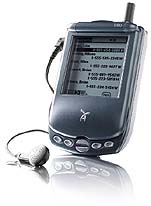 PDA
PDA
Both versions of the 180 have 16 MB of RAM. They run the 33 MHz Dragonball VZ processor that is in just about all Palm OS handhelds these days and use Palm OS 3.5. They are capable of running all Palm OS applications that run under OS 3.5.
Like the Visor models, the Treo smartphones come with Date Book+, which is Handspring's enhanced version of the standard Palm Date Book.
These are not the "Visor Treo". The Treo line is separate from Handspring's Visor line. As such, they do not have Springboard slots. They also can't use Visor peripherals, like external keyboards.
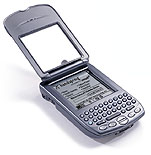 Physically, both versions of the 180 are 4.3 by 2.7 by 0.7 inches and weighs 5.4 ounces. This makes them among the very smallest Palm OS handhelds available.
Physically, both versions of the 180 are 4.3 by 2.7 by 0.7 inches and weighs 5.4 ounces. This makes them among the very smallest Palm OS handhelds available.
They have a jog wheel, which Handspring is calling a Jog Rocker. This is the first Handspring model to feature one. The company has worked to integrate the Jog Rocker into the functioning of the Treo line as much as possible.
Neither version comes with a cradle. Instead they have HotSync cable. It is a single USB cable that splits with one strand for data and another that plugs into a wall socket for power. A cradle will be sold separately.
They use li-ion rechargeable batteries. The batteries are good for two hours of talk time and more than 60 hours on standby. The manual says the batteries can be fully charged in only an hour.
On the top is the power button, an infrared port, the antenna, a switch to turn the ringer off, and a single LED used to indicate both battery status and whether the device is in range of a transmitter.
Mobile Phone
The speaker on the Treo is inside the flip cover. The user can talk by placing the inside of the flip cover to their ear and speaking into the microphone built into the front.
It also comes with a tiny headset for those that don't like to put the handheld up to their face. This has a button on it that allows the user to answer the phone. The 180 and 180g can also be used as a speakerphone.
It has other handy functions like 3-way conference calling and Caller ID.
It is a GSM phone and there will be a 900/1900 MHz for North America and a 900/1800 MHz version for Europe and Asia. SIM cards from other phones can be plugged into them.
These devices will require only a software upgrade to be ready for GPRS. Handspring expects to have the software upgrade ready during the second quarter of next year, which is when they expect GPRS to begin to be widely available.
They have already lined up an impressive collection of wireless service providers. In the U.S., this includes Cingular and VoiceStream They also have agreements with companies in Canada and no less than eleven wireless providers in Europe.
Handspring had added an application to let the Treo models be used as mobile phones. This app is launched with the Phone Book button, which replaces the Address Book button on the front of the unit.
It has four main screens. The first is a contacts list which essentially just displays names and phone numbers. The first picture with this article shows this screen. This can be scrolled through and numbers dialed with the Jog Rocker. Tapping on an entry opens full address info.
For users with large numbers of stored phone numbers, entries can be looked up by entering the first letter of the first name then the first two letters of the last name.
The other main screens are the Dial Pad, which looks the buttons on a regular phone, Speed Dial, and Call History.
Data
Both allow Web surfing via a new version of Handspring's Blazer. This allows up to 100 sites to be bookmarked. This list can be moved through and sites can be opened with the Jog Rocker. In fact, Handspring has designed this version of Blazer to allow the user to surf almost exclusively with the Jog Rocker.
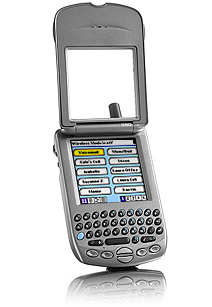 They also come with an SMS application that allows messages to be sent to and received from GSM phone numbers and can also send messages to email addresses. The keyboard on the Treo 180 has been designed to make this as easy as possible and includes special purpose buttons like 'Send' and 'New".
They also come with an SMS application that allows messages to be sent to and received from GSM phone numbers and can also send messages to email addresses. The keyboard on the Treo 180 has been designed to make this as easy as possible and includes special purpose buttons like 'Send' and 'New".
There will also be a POP3 client included on CD that will allow full email functionality. This is JPMobile's One-Touch Mail. Initially, this will require the user to manually check to see if there is any email waiting. Handspring is working on a push email system in which the Treo will be able to download email automatically. This won't be available until the middle of 2002 and will only require a software upgrade to work.
Treo 270
As mentioned earlier, Handspring plans to introduce the Treo 270 by mid-2002. Not surprisingly for a handheld about nine months away from being released, they don't have a lot of details. However, Handspring is saying it will be offer "great" visibility both indoors and out and the device will have the same battery life as the monochrome versions.
They are committed to releasing a keyboard version but they might also make one that uses Graffiti, depending on customer demand. They will be using sales of the two versions of the 180 as their guide. At this point, many people at Handspring believe that the keyboard version will do better than the graffiti one.
Like the 180, there will be two versions of the 270, one for the U.S. and the other for Europe and Asia.
Treo 600
From Wikipedia, the free encyclopedia
| Treo 600 | |
 | |
The Treo 600 is a smartphone, combining a color Palm OS PDA with a regular sized mobile phone. It was developed by Handspring, and offered under the palmOne brand (now Palm, Inc.) after the merger of the two companies. It has a number of integrated features and it is possible to check the calendar while talking on the phone, dial directly from contacts list, take pictures or send emails. It includes a five-way navigation button and favorites screen allowing quick access to the phone functions.
On October 24, 2004, palmOne officially unveiled the Treo 600's successor, the Treo 650.
[edit] Design
The Treo 600 is a rather large device by cell phone standards but compact for a PDA. The 600 is slightly longer and thicker than its predecessor and is also nearly half an inch narrower giving it a more cell-phone like feel. The new form factor has been compared to a candy bar or a bar of soap. The design is definitely an example of form-follows-function, the front of the phone consists of a full QWERTY keyboard at the bottom with menu and home buttons at the bottom right. Above the keyboard are the 4 application buttons with a five-way navigator in-between. Each application button can be mapped to two applications with the exception of the last button which has one of its functions permanently mapped to the key guard. Pressing the button once takes the user to the primary application and hitting the silver alternate function button followed by an application button takes the user to the secondary application. Above the buttons and navigator is a small Treo logo and the large 160x160 color touch screen.
The top of the phone is occupied by the earpiece, fat antenna, SDIO/MMC slot; in front of the slot is the Infrared port with the power button on the antenna side which can be used to turn off the screen, or, if held down for a few seconds can turn off the radio and put the phone in a sort of "air plane mode". Opposite of the IR port is a switch which, by default is set to switch between normal ringer operation and silent mode with vibration. The back of the Treo is simple enough with a palm logo at the bottom with a reset pin hole offset to the right.
On the back of the phone towards the top is a sticker with various serial numbers and a triangular shaped speaker grill offset to the left. Above the speaker grill is the VGA camera lens and the top of the stylus is visible above and to the left of the lens. The stylus itself slides into a silo opposite the antenna and when the stylus is stored the top sits flush with the curvature of the phone with the exception of a notch which is used to lift the stylus out of its silo.
The bottom of the Treo houses the 2.5mm jack which can output stereo sound and accept a standard headset (requires a converter). Next to the audio jack, in the center of the phone, resides a connector used for data transfer and charging. The upper left side of the phone contains 2 volume keys, the right side is a mirror image of the left without the volume keys.
[edit] Specifications
- Mobile phone, GSM/GPRS model with 850/900/1800/1900 MHz bands, CDMA model with 800/1900 MHz bands.
- 144-MHz ARM processor.
- 32 MB RAM (24 MB available storage).
- Built-in rechargeable lithium ion batteries, lasting more that 24 hours in normal usage.
- Palm OS ver 5.2.1H complete with standard applications including web browsing, email, calendar, and contacts.
- Size 4.4 × 2.4 × 0.9 inches (11.2 × 6.0 × 2.2 cm)
- Weight 5.9 oz. (168 grams)
- Display 160×160 pixels CSTN backlit display
- SDIO / SD / MMC memory slot.
- MP3 and stereo audio headset compatible (requires a converter to accept standard headset).
- Digital camera VGA (640×480) resolution (Most models)
- Infrared com port and touch-screen with stylus.
- Backlit keyboard with phone dial layout.
- Speakerphone and vibrate mode.
Treo™ 680 smartphone

It's time to expect more from your phone.
Say hello to the Palm® Treo™ 680 smartphone. It's your phone along with email, messaging, and web access.3 Not to mention your contacts, calendar, photos, and songs. Sounds like a lot. And it is. But everything's so easy to learn that you'll actually use it, which makes it anything but a typical phone.
The same goes for design. Pick it up and you'll notice a large color touchscreen and an easy-type keyboard. Since the Treo 680 is just the right size, you have the freedom to take it anywhere and still be connected to friends, work, and family.4 Of course, there's also something called an "off" button, for when you don't want to be connected at all.
Treo™ 700p smartphone

The Palm® Treo™ 700p smartphone delivers everything you need in one go-anywhere, Palm OS® device. It combines a smarter phone with wireless email2 and messaging,2 built-in web browser,2 and rich media capabilities—all at blazing fast broadband-like speeds.3
Be productive even while you're away from your desk. Work on important files with built-in support for native Microsoft® Word, Excel®, and PowerPoint® documents, a PDF viewer, and 60MB of dedicated user storage.
Treo™ 700w|wx smartphone


Unify. Simplify.
Palm's world-class ease of use, now on Windows Mobile®The Palm® Treo™ 700w and 700wx smartphones deliver everything you need without compromise. They combine a smarter phone with broadband-like speeds2, wireless email3, including Windows Mobile® Direct Push Technology4,and rich-media capabilities, all in one—bringing Palm's world-class ease of use to the Windows Mobile platform.
Connect with people in multiple ways—by voice, email or SMS. Your contacts are always reachable, from any application. Access email, the web and corporate networks on one of the fastest networks available in the U.S.2, 3 Or relax and play your favorite music and videos right on your device. With these easy-to-use productivity devices in hand, you can stay connected3 on your terms.
Learn about details for Treo 700w|wx.
Treo™ 750 smartphone

![]()
Your world. At broadband speeds.
Windows Mobile®. Palm ease. International network.The Palm® Treo™ 750 smartphone goes where you go. It combines a world GSM phone2, email3, broadband wireless4, and Windows Mobile®—all with world-renowned Palm ease. And the sleek, midnight blue design with our new soft-touch finish feels great in your hand.
Review and edit business documents and access corporate data. Answer calls as you check email. And with Microsoft's Direct Push Technology built in, you can get your Outlook® email, as well any changes to your Calendar, Contacts, and Tasks in seconds4. Or kick back, play music, shoot videos, and surf the web4. All the functionality is elegant and seamless thanks to Palm enhancements on the Windows Mobile platform that'll save steps and your valuable time. Get the all-in-one smartphone that puts you in control.
Treo™ 755p smartphone

The Palm® Treo™ 755P smartphone delivers everything you need in one go-anywhere, Palm OS® device. It combines a smarter phone with wireless email2, a built-in web browser,2 and rich media capabilities—all at blazing, broadband-like speeds.3
Be productive, even away from your desk. Work on important files with built-in support for native Microsoft® Word, Excel®, and PowerPoint®4 plus PDF documents. A full QWERTY keyboard and color touchscreen make composing email and surfing the web easy.2





 Make Money Online
Make Money Online

|